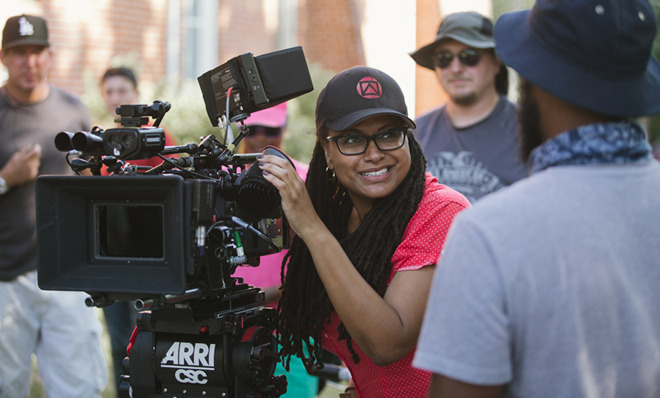Girls on Film: The 4 percent problem for female directors continues in 2015
The new year extends a sad pattern


By the end of last year, over 100 wide releases were scheduled for 2015. Of those, a whopping seven are directed by women. Three will screen in February, and two in May. Most of the women's work will be battling each other for box office supremacy, and audiences will enjoy only four months with new wide-release films from female directors.
The year will start out strong. After Ava DuVernay's 2014 Oscar-destined film Selma hits wide release in January, February will be the biggest month for women behind the camera. The long-awaited and delayed releases of Lana and Andy Wachowski's Jupiter Ascending on Feb. 6, and Niki Caro's Disney sports drama McFarland, USA on Feb. 20 will bookend the month. Nestled right between them is Sam Taylor-Johnson Valentine's release of 50 Shades of Grey.
The next two releases from female directors will hit in May at the start of blockbuster season. Anne Fletcher's action comedy Don't Mess with Texas faces off against a week-old Avengers: Age of Ultron on May 8, and Pitch Perfect 2 arrives the following week on the May 15, against Mad Max: Fury Road.
Subscribe to The Week
Escape your echo chamber. Get the facts behind the news, plus analysis from multiple perspectives.

Sign up for The Week's Free Newsletters
From our morning news briefing to a weekly Good News Newsletter, get the best of The Week delivered directly to your inbox.
From our morning news briefing to a weekly Good News Newsletter, get the best of The Week delivered directly to your inbox.
The only two remaining wide releases that are currently scheduled are Thea Sharrock's romance Me Before You in August, and Nancy Meyers' The Intern in September.
This means that of the roughly 113 wide releases scheduled before the New Year, 6.6 percent are directed by women. Superficially, this looks like an improvement on last year's decrease to a paltry 4 percent. However, these numbers are subject to change, and as much as limited releases might go wide and improve the numbers, scheduling changes can also hurt them. Two of the films that make up this year's 6.6 percent are Jupiter Ascending and McFarland, USA — which are two of the films that made up last year's list, before their dates were pushed. If we remove them from this year's tally of new films, we're left with the very same terrible 4 percent.

If we add in the indie films already primed for release in 2015, the number jumps by five – Little Accidents, Song One, and Veronika Decides to Die (January 23), Serena (March 27), and Infinitely Polar Bear (April 24). Unfortunately, yet again, if we remove long-delayed films and leave what is truly new, only three new movies are added to the list. Emily Young's Veronika Decides to Die, starring Sarah Michelle Gellar, was first released in international markets as far back as 2009, and Susanne Bier's Serena — starring Jennifer Lawrence and Bradley Cooper — was filmed before their collaboration in Silver Linings Playbook, but dueling schedules and paltry studio offers saw the film languish.
Independent film numbers are primed to increase as more 2014 festival favorites find their way into distribution in the New Year, and early 2015 favorites grab attention. The Sundance Film Festival, which made history a few years ago as the only fest to offer an equal number of male and female-directed films in competition, offers a still-strong 36 percent this year. But these aren't films that get released across the country.
Sign up for Today's Best Articles in your inbox
A free daily email with the biggest news stories of the day – and the best features from TheWeek.com
Lynne Ramsay's award-winning, Cannes-premiering We Need to Talk About Kevin reached only 80 screens in its widest release. Ava DuVernay's award-winning Middle of Nowhere, which won her the Best Director prize at Sundance in 2012 and was a stepping stone to Selma, reached only 25 screens in its widest release. If you add up all the screens Sundance favorite Lynn Shelton's five releases hit, the number is only 440 (that's just 16 percent of the screens the 100th most successful movie of 2014, As Above/So Below, reached).
As much as indie releases can help the overall output, only wide releases have any chance of reaching audiences at large, and not just lucky folks in a few major cities. This means that the screens continue to be dominated by men and male-centric stories because the number of men and women on-screen and behind the scenes changes depending on who's in the chair. In 2013, one study revealed that there is a 21 percent increase of women on set (in various roles) when women earn the director's chair. Since the percentage of female directors in Top 250 films decreased 3 percent in the 15 years since 1998, it is no surprise that yearly stats continue to show Top 100 studio films offer no more than 33 percent speaking roles for women, and no more than 17 percent balanced casts.
The female characters appearing in 2015 films are generally positioned as supporting wives, paramours, and mothers. There are films that joke about killing wives, action adventures where men must avenge their fallen daughters, wives, and friends, and one woman contemplates giving up her immortality and facing death for love. There is a film about a boy robot adventurer, and another where men are "evaluating the human qualities" of a sexy female Artificial Intelligence.
Though we no longer have a female M in the James Bond series, there appear to be some lights in 2015's dark tunnel. Salma Hayek will be the year's lady asskicker in Everly; Britt Robertson will star in the much-buzzed Tomorrowland; the Paul Feig + Melissa McCarthy collaborations continue with the adventure comedy Spy; Meryl Streep will play an aging rockstar in Ricki and the Flash; Amy Poehler and Tina Fey will return to screens with Sisters; and, of course, we're all waiting to see just how diverse the main roles in Star Wars: The Force Awakens are.
Like each year before it, 2015 will be one where audiences interested in seeing diverse narratives, helmed by diverse talent, will have to hunt and travel. Even if we put on blinders and ignore that a number of this year's new releases from women were originally slated as 2014 releases, if we cling to that 6.6 percent, ignore how the stats have declined in the last 15 years, and choose to believe the numbers will go up 1.6 percent every single year, we would finally reach parity … in 2043. But if you believe people like Steven Spielberg and George Lucas, the system could be dead before then.
Girls on Film is a weekly column focusing on women and cinema. It can be found at TheWeek.com every Friday morning. And be sure to follow the Girls on Film Twitter feed for additional femme-con.
Monika Bartyzel is a freelance writer and creator of Girls on Film, a weekly look at femme-centric film news and concerns, now appearing at TheWeek.com. Her work has been published on sites including The Atlantic, Movies.com, Moviefone, Collider, and the now-defunct Cinematical, where she was a lead writer and assignment editor.
-
 How to create a healthy 'germier' home
How to create a healthy 'germier' homeUnder The Radar Exposure to a broad range of microbes can enhance our immune system, especially during childhood
-
 George Floyd: Did Black Lives Matter fail?
George Floyd: Did Black Lives Matter fail?Feature The momentum for change fades as the Black Lives Matter Plaza is scrubbed clean
-
 National debt: Why Congress no longer cares
National debt: Why Congress no longer caresFeature Rising interest rates, tariffs and Trump's 'big, beautiful' bill could sent the national debt soaring